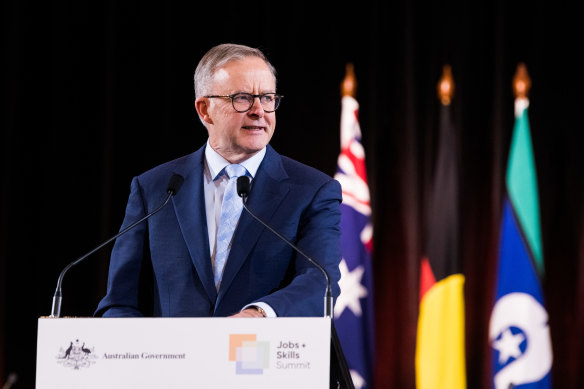Key points
- This year’s permanent overseas migration intake to be increased by 35,000, or more than 20 per cent, to a record 195,000.
- The amount aged pensioners can earn before having their annual payment cut increased by $4000.
- $575 million more funding for National Housing Infrastructure Facility to attract outside investment in affordable housing.
- $36.1 million to employ 500 people over the next nine months to address the backlog in processing 900,000 visa applications.
- Post-study work rights for international students with Australian degrees in areas with verified skill shortages increased by two years.
An extra 35,000 immigrants and thousands of aged pensioners will be used to help deal with worker shortages as the federal government aims to overhaul the nation’s migration program to focus on permanent rather than temporary residents.
During its two-day jobs and skills summit, the government revealed this year’s permanent overseas migration intake would be increased by more than 20 per cent to a record 195,000. Beyond that, the intake – cut by the Morrison government to 160,000 – is likely to remain close to the new figure.
Prime Minister Anthony Albanese wrapping up the jobs and skills summit. “My starting point is in favour of giving people the security that comes with a path to permanent migration, a path to being an Australian citizen.”Credit:James Brickwood
To offset concerns in some parts of the community that the lift in migration will put pressure on the housing market, the government will pump up to $575 million more into the National Housing Infrastructure Facility. It will be used to attract more outside investment, including from superannuation funds, into affordable housing.
The government will also try to encourage people on the aged pension back into the workforce, increasing by $4000 the amount they can earn before having their pension reduced.
It takes to almost $12,000 a year what an aged pension recipient can earn without losing part of their $26,700 annual payment. Changes will also be made to ensure they retain access to the pension concession card for two years if they exceed their income limit.
The changes around migration include $36.1 million to employ 500 people over the next nine months to address the backlog in processing 900,000 visa applications, and increasing by two years post-study work rights for graduates with Australian degrees in areas with verified skill shortages.
Temporary migrants working on Australian farms will probably be given the freedom to work across multiple employers as a safeguard against exploitation after a new agreement was reached between the agriculture industry, unions and the government to lift standards sector-wide.
In a sign the government is preparing for more substantial changes around migration, Prime Minister Anthony Albanese said there had been an overreliance on temporary labour in specific industries in the past, making the country more vulnerable when visa holders were asked to leave Australia as the border was shut during the COVID-19 pandemic.
“My starting point is in favour of giving people the security that comes with a path to permanent migration, a path to being an Australian citizen,” he said.
Business Council chief executive Jennifer Westacott said the government’s decision to lift the permanent migration cap was a “really sensible decision”, despite falling short of the BCA’s proposal of up to 220,000.
“It’s going to put thousands of workers into the system. So too is the commitment to fast-track the processing of visas that are stuck in the system. This is a hugely important announcement,” she said.
The Australian Retailers Association said the increase in the migration intake and extra funding to speed up visa processing were significant policy wins.
“We’re in a global race for talent and we need to ensure Australia is an attractive destination to work and visit,” ARA chief executive Paul Zahra said.
Treasurer Jim Chalmers said the government had been preparing a plan to get older Australians working more if they wanted to since before the election. The measure, which is a trial for the rest of this financial year, is expected to cost $55 million.
“It’s a time-limited measure [that] we hope spurs some additional workforce participation amongst older Australian workers,” he said.
National Seniors chief advocate Ian Henschke said the $4000 increase in what pensioners could earn before their entitlement was reduced was a welcome step, but urged the government to go further.
“This could have been targeted at areas such as healthcare and the childcare sectors where there are substantial shortages of workers,” he said.
Minister for Women Katy Gallagher said women were front and centre of the summit. The government has committed to changes requiring companies with more than 100 employees to report their gender pay gap to the Workplace Gender Equality Agency, and providing education and self-assessment tools so businesses can be acknowledged as “carer-friendly” workplaces.
“In short, I just reckon women nailed it at this summit,” she said.
“For me, the most important outcome of this summit was that women’s equal participation, gender equality, is recognised unanimously by everyone who attended the summit as critical to our economic resilience and prosperity.”
Chalmers said there were 36 “concrete areas of action” with a similar number of proposals that would be considered in the coming months or as part of the summit’s employment white paper that is due to be completed within 12 months.
Next week’s cabinet meeting will start considering some of the legislation needed to back up the agreements made at the summit, which was attended by 142 people from business, unions, community organisations and the states.
The Liberal Party vetoed the summit, labelling it a talkfest. But Nationals leader David Littleproud attended, saying the government should look at paying the HELP debts of registered nurses and pharmacists who worked in regional areas.
Liberal immigration spokesman Dan Tehan said it was important that proper visa processes were maintained, adding that a possible overhaul of the entire visa system would be a good step.
“If we can simplify the system that would be a real positive,” he said.
Cut through the noise of federal politics with news, views and expert analysis from Jacqueline Maley. Subscribers can sign up to our weekly Inside Politics newsletter here.
correction
A previous version of this article said the Turnbull government cut the permanent migration intake to 160,000. It should have said the Morrison government.
Most Viewed in Politics
From our partners
Source: Read Full Article

